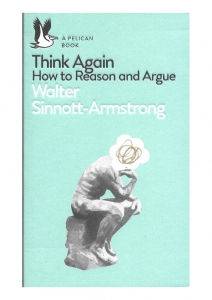The one sentence summary
Don’t simply declare what you believe – offer arguments.
WHAT THE BOOK SAYS 
- Arguments are not shouting matches – they are supposed to be constructive. An argument is defined as when someone (the arguer) presents one claim (the premise) as a reason of some kind for another claim (the conclusion). It is a connected series of statements intended to present a reason for a proposition.
- A classic argument shape is:
- Observation (I see that…)
- Hypothesis (So I think that x is the case)
- Comparison (This explanation is better than other possibilities)
- Conclusion (Therefore x is the case)
- How to be civil when arguing:
- Re-express the other person’s position clearly, vividly and fairly so they wish they had put it that way themselves.
- List any points of agreement.
- Mention anything that you have learned from them.
- Only then are you permitted to challenge or criticise.
- Argument markers are words like ‘so’ and ‘because’ that signal that an argument is being given.
- Infinite regress is when an argument never ends because there is always another level of justification needed.
- This can be halted by four types of regress stoppers:
- Guarding (introduce uncertainty as in some but not all)*
- Assuring (judgments that only apply if you are trusted). But beware abusive assuring, as in “You would have to blind not to see that…”
- Evaluating (evaluative words like good and bad cannot be proven or disproven)
- Discounting (anticipate and defuse objections, then discount them)
- *Also try asking: What do you mean: all, some, many or most?
WHAT’S GOOD ABOUT IT
- How to question someone’s stated authority:
- Did they cite the authority correctly?
- Can that authority be trusted to tell the truth?
- Is the cited authority in fact an authority in the appropriate area?
- Is there agreement among appropriate experts on this issue?
- Why is an appeal to authority being made at all?
- Arguments suffer variously from fallacies of composition (what holds for parts may not for the whole), division (what holds for the whole may not hold for parts), and dichotomy (people can be neutral – neither for nor against).
WHAT YOU HAVE TO WATCH
- There is a lot of semantics involved, so you need to concentrate hard.
